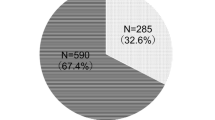Abstract
Objective
To evaluate the correlates of nocturia and subsequent mortality in patients with type 2 diabetes mellitus (T2DM).
Methods
A self-administered questionnaire containing overactive bladder symptom score was obtained from subjects with T2DM. Nocturia and severe nocturia were defined as rising ≥2 or ≥3 per night to void, respectively. Patient characteristics and diabetes-related complications to risk of nocturia were evaluated.
Results
Of 1,301 consecutive subjects, 59.6 and 25.3 % reported having nocturia and severe nocturia, respectively. The presence and severity of nocturia increased with age and overactive bladder (OAB). The presence of OAB was 28.8 % in patients with nocturia and was significantly associated with nocturia (OR 2.26) after adjustment for age and duration of DM. The presence of stroke, calcium channel blocker use, hypertension, waist circumference greater than standard, albuminuria, and higher serum creatinine level, and high-sensitivity C-reactive protein was associated with nocturia and severe nocturia after adjustment for age, duration of DM, and the presence of OAB. Higher estimated glomerular filtration rate, hemoglobin, serum albumin, and male gender were less likely to have nocturia (OR <1). Severe nocturia increased mortality (OR 1.93) independent of age and DM duration and has a higher mortality rate compared to those without severe nocturia (6.1 vs. 2.4 %, P = 0.001) in 2.5 years follow-up.
Conclusions
While OAB is an important predictor of nocturia in T2DM patients, systemic issues, including stroke, hypertension, obesity, and chronic kidney disease, have further impact on nocturia independent of OAB. Severe nocturia is a marker for increased mortality.


Similar content being viewed by others
References
van Kerrebroeck P, Abrams P, Chaikin D et al (2002) The standardisation of terminology in nocturia: report from the standardisation sub-committee of the international continence society. Neurourol Urodynam 21:179–183
van Dijk L, Kooij DG, Schellevis FG (2002) Nocturia in the Dutch adult population. BJU Int 90:644–648
Fitzgerald MP, Litman HJ, Link CL, McKinlay JB (2007) The association of nocturia with cardiac disease, diabetes, body mass index, age and diuretic use: results from the BACH survey. J Urol 177:1385–1389
Ruud Bosch JLH, Weiss JP (2010) The prevalence and causes of nocturia. J Urol 184:440–446
Irwin DE, Milsom I, Hunskaar S et al (2006) Population-based survey of urinary incontinence, overactive bladder, and other lower urinary tract symptoms in five countries: results of the EPIC study. Eur Urol 50:1306–1315
Liu RT, Chung MS, Lee WC et al (2011) Prevalence of overactive bladder (OAB) and associated risk factors in 1,359 patients with type 2 diabetes. Urology 78:1040–1045
Gulur DM, Mevcha AM, Drake MJ (2011) Nocturia as a manifestation of systemic disease. BJU Int 107:702–713
Yoshimura K (2012) Correlates for nocturia: a review of epidemiological studies. Int J Urol 19:317–329
Yamaguchi C, Sakakibara R, Uchiyama T et al (2007) Overactive bladder in diabetes: a peripheral or central mechanism? Neurourol Urodynam 26:807–813
Yoshimura N, Chancellor MB, Andersson KE et al (2005) Recent advances in understanding the biology of diabetes-associated bladder complications and novel therapy. BJU Int 95:733–738
Homma Y, Yoshida M, Seki N et al (2006) Symptom assessment tool for overactive bladder syndrome: overactive bladder symptom score. Urology 68:318–323
Liew LC, Tiong HY, Wong ML et al (2006) A population study of nocturia in Singapore. BJU Int 97:109–112
Tibaek S, Gard G, Klarskov P et al (2008) Prevalence of lower urinary tract symptoms (LUTS) in stroke patients: a cross-sectional, clinical survey. Neurourol Urodyn 27:763–771
Hsu CY, Iribarren C, McCulloch CE et al (2009) Risk factors for end-stage renal disease: 25-year follow-up. Arch Intern Med 169:342–350
Calhoun DA, Harding SM (2010) Sleep and hypertension. Chest 138:434–443
Subak LL, Whitcomb E, Shen H et al (2005) Weight loss: a novel and effective treatment for urinary incontinence. J Urol 174:190–195
Tai HC, Chung SD, Ho CH et al (2010) Metabolic syndrome components worsen lower urinary tract symptoms in women with type 2 diabetes. J Clin Endocrinol Metab 95:1143–1150
Wu MY, Wu YL, Hsu YH, Lin YF, Fan YC, Lin YC, Chang SJ (2012) Risks of nocturia in patients with chronic kidney disease- doe the metabolic syndrome and its components matter? J Urol 188:2269–2273
Kupelian V, McVary KT, Barry MJ et al (2009) Association of C-reactive protein and lower urinary tract symptoms in men and women: results from Bostonarea community health survey. Urology 73:950–957
Lu Z, Gao Y, Tan A et al (2012) Increased high-sensitivity C-reactive protein predicts a high risk of lower urinary tract symptoms in Chinese male: results from the Fangchenggang Area Male Health and Examination Survey. Prostate 72:193–200
van Doorn B, Kok ET, Blanker MH et al (2012) Mortality in older men with nocturia. A 15-year followup of the Krimpen study. J Urol 187:1727–1731
Kupelian V, Fitzgerald MP, Kaplan SA et al (2011) Association of nocturia and mortality: results from the Third National Health and Nutrition Examination Survey. J Urol 185:571–577
Asplund R (1999) Mortality in the elderly in relation to nocturnal micturition. BJU Int 84:297–301
Acknowledgments
Authors received funding support from CMRPG 860381.
Conflict of interest
Authors have no conflict of interests to declare.
Author information
Authors and Affiliations
Corresponding author
Additional information
Rue-Tsuan Liu and Yao-Chi Chuang have contributed equally to this study.
Rights and permissions
About this article
Cite this article
Chung, MS., Chuang, YC., Lee, JJ. et al. Prevalence and associated risk factors of nocturia and subsequent mortality in 1,301 patients with type 2 diabetes. Int Urol Nephrol 46, 1269–1275 (2014). https://doi.org/10.1007/s11255-014-0669-2
Received:
Accepted:
Published:
Issue Date:
DOI: https://doi.org/10.1007/s11255-014-0669-2




